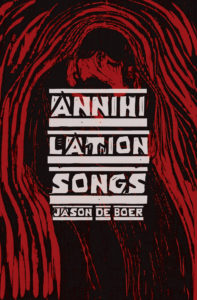It appears crucial to Jason DeBoer’s diminutive book of short fictions Annihilation Songs that its lexicon is derived from the words utilized by Shakespeare in three of his plays — Hamlet, The Tempest, and The Two Gentlemen of Verona. In acknowledgments nearest to the text itself, both the introduction by writer and publisher Tosh Berman and the author’s preface (and an additional author’s note) present the tactic. The fact is also the lede on the jacket copy. The query email I received about the book mentioned its Oulipian conceit. My writing this review right now is adding further shading to the gaseous orbitals of Annihilation Songs’ paratext. So it goes outward in paratextual shells from the seed text. Yet, the texts themselves, these three tight pieces, do not tip their hand to the conceit, do not nudge the reader. They are rather comfortable and tidy. They do not strain — an etymological predisposition of works defined by constraint. The entire tactical prehistory of the reading performance is contained in the book’s paratext. This is not strange for most books, whose compositional practice is irrelevant, is an exultation of raw imagination. But for a book with such a calculated and idiosyncratic disposition, it begs the question of how apparent such a tactic should be in the experience of the book.
At some point, nearly every creative practitioner seeks techniques for getting out of their own way. Some begin to find the allure inescapable. In architecture for example, designers have concocted entirely parametric situations, frequently themselves willful constructs, that play out form-making processes to unexpected and inarguable endgames. The architect Greg Lynn developed time-based animation procedures that sculpted form and space from a genetic seed, playing out temporally a result that would be cemented in static built compositions. Underlying many of these endeavors is the air that the concoctor has “solved” the problem of creativity for the rest of the beleaguered makers out there. This rings especially true in the more transparent exemplars of this type of creative work. These are primarily what I will discuss here. But even in my anointing of these tactics it should be clear that I still regard them as fragile, as people searching for a way to make passing time into something that is theirs.
I begin with consideration of a likely progenitor to DeBoer’s project, William S. Burroughs, and a conversation he had with Fred Jordan, an editor for Grove Press, in 1980, recounted by writer Victor Bockris:
Burroughs: I met Beckett once in (Maurice) Girodias’s restaurant in Paris.
Jordan: Was that the time when, apparently, you explained to Beckett the cut-up method and he responded by saying, “But . . . but that’s plumbing, that’s not writing!”
Burroughs: Oh, yes, he was quite upset by the whole thing. “You’re using other people’s words!” he said at one point. I said, “Well, the formula of one physicist is after all available to anybody in the profession.”
Beckett’s puzzlement is especially interesting to me in that he too used other peoples’ words. Words are inherently not the property of the author. For them to be communicative in any shared way they must belong to others as well. Although I understand Beckett’s perspective; his disagreement with Burroughs reflects a value judgment imposed on different scalar units of source material, the word being more fair-use than the phrase. A sequence of words is seen as having a lesser probability of occurring together and has more likelihood of belonging specifically to another individual. It contains more information. The longer the sequence unfolds, the more likely it is appropriated. Such is the mechanism of automated searching for plagiarism in academic papers. As far as the cut-up goes, in that accumulation of information, in the gathering together of more momentum toward normalcy, it embodies more disruption when, through juxtaposition, the discontinuity belies that normalcy.
Burroughs said, “All writing is in fact cut-ups.” And although this is conceptually true, the performative value of an actual cut-up is far different from that of conventional writing. For example, read this excerpt from his book, The Soft Machine:
He went to Madrid . . . Alarm clock ran for yesterday . . . “No me hágas casa.” Dead on arrival . . . you might say at the Jew Hospital . . . blood spilled over the American . . . trailing lights and water . . . The Sailor went so wrong somewhere in that grey flesh . . . He just sit down on zero . . . I nodded on Niño Perdido his coffee over three hours late . . . They all went away and sent papers . . . The Dead Man write for you like a major . . . Enter vecinos . . . Freight boat smell of rectal mucus went down off England with all dawn smell of distant fingers . . . About this time I went to your Consul. He gave me a Mexican after his death . . . Five times of dust we made it . . . with soap bubbles of withdrawal crossed by a thousand junky nights . . .
The prose traffics in parataxis and discomfort, yet, because of the unit size — sentence fragments rather than words — it still has meaning. Cut-up at the level of the word, if intention is relinquished to the process, would result in nonsense. Here is a Bashō haiku run through the random.org list randomizer: “foretell must can cry How No die. In cicada’s the soon sign it.” The overall length of the original piece and the inherent parataxis of haiku allows the word-level cut-up to maintain a semblance of meaning. It continues to evoke the original. Here is Prince Hamlet’s Act 3 Scene 1 soliloquy run through the same process:
To oppressor’s bare we the orisons the The rub, hue more–a quietus we question: be, not of thus conscience does returns, so of Who o’er under of you To scorns That cast And awry insolence sea pause. Whether calamity know we bear makes to But in he action. And weary the currents The of? consummation office, patient To end of the And thousand to of of to and may to. With troubles us those sleep thought, is Must die, a is sleep bodkin? takes, There’s have all unworthy to fair his a bear mortal against arms and Is enterprise dream: For Thus not sicklied . . .
You get the idea. It borders on — a rather lovely — nonsense. The preponderance of articles and their agrammatical clustering is, beyond the shuffled meaning, a transparent signpost of a process at work. The catalog is deeper — the wordcount close to 300 — and the dislocation of components becomes more pronounced, thus the apparent relationship to the source begins to fall apart (except for idiosyncratic giveaways like “bodkin”). Finally, here is an excerpt from DeBoer’s Hamlet “reintegration”:
The private swore under his breath, but Laertes would not unhand his shoulder. Cornelius Struck wildly and his pick-axe hit the sergeant in the skull. The two other privates, speechless, jaws open, scanned the scene. The hush was murderous. The company tyrant was now just a barefaced object bleeding in the dust.
As with the randomized soliloquy, there are giveaways in DeBoer’s text, specifically the name “Laertes.” Neither my text nor DeBoer’s has a significantly distinct relationship to the plot of Hamlet. But in DeBoer the texture is different, or, it is a conventional texture. The project is opaque. The effect of articles and pronouns for instance, doing their proper work on the smoothness of language, the opacity of the reading experience. The work ultimately still relies on DeBoer’s compositional will. And because of the length of the book’s pieces, and because of the unburdening of not using every word from the original works, the syntax of struggle does not prevail. The text falls in a readerly place far more similar to Beckett’s abiogenesis. Yet, the paratextual insistence cloaks every word. Annihilation Songs is a book from books. Here is another conversation about Beckett recounted by Victor Bockris, this time between Susan Sontag and Burroughs:
Sontag: Do you think he reads much?
Burroughs: I would doubt it. Beckett is someone who needs no input as such…
Sontag: It’s interesting that you say he doesn’t need any input. That’s true. There are no references in his work, nothing that appears from the outside.
Burroughs: Because most writers do. For example, I get a lot from reading, I get a lot from newspapers, but with Beckett it’s all inside, I don’t think he needs that sort of thing at all.
Sontag: I wonder if he has many books. I would think not.
Burroughs: I didn’t see any while we were there, but those of course were temporary quarters.
Sontag: People who are involved in books always manage, even on a trip, to accumulate some.
Burroughs: That’s true. I saw no books.
It would be one thing to write such a text and not leak its conceit. In a way though, to foist the labor of unveiling the compositional history, the situation of the literature, outside the text, is to have one’s cake and eat it too. Joyce famously provided schemata decoding Ulysses to his friends Stuart Gilbert — who published his — and Carlo Linati — who gave his to the book’s publisher, Sylvia Beach. The episode titles from the schemata — Telemachus, Nestor, Proteus, etc.—appear nowhere in the actual text, where they are 1, 2, 3, etc. Yet our contemporary understanding of the text is so shaded by the schemata that when we look at the number 18 on the last section, we actually see the word “Penelope.” A similar effect is taking place in Annihilation Songs.
Further consideration of the question of tactical transparency can be explored vis-à-vis the body of work in literature that has most embraced such the strategy of constrained writing, the Oulipo. Within the group there are a variety of manifestations. On one hand I would place the lipogramatic constraint, most famously exemplified by Georges Perec’s A Void, which eschews the letter “e”. Perec adopts the conventions of a detective story to dance around the absence of the letter. Solve the detective story and you solve the tactical impetus for the book. There are, of course, other clues. For instance, my copy has the letter “e” inside an interdictory circle. But it is the content of the book itself, in addition to often strange word choices and a vague visual nagging feeling, that declare self-reflexively its compositional history. On the other end I might describe Oulipo works that are more procedurally constrained, like Jacques Roubaud’s The Great Fire of London and subsequent volumes of his “project”. Apart from the mathematical constructs involved in its composition, the constraint here is to write straight through with no editing, making physical the imprint of passing time being left inaccessible in the past. This in and of itself does not lead to a work with tactical legibility — although Roubaud does write about the approach within the actual text. What does provide the project with its legibility is Roubaud’s adoption of “bifurcations and interpolations,” a series of texts out of sequence that belong to, or expand a thought not directly addressed at the time. This product of the compositional tactic produces an effect of discontinuity, of artificiality and artifice, like the endnotes of Infinite Jest, that says to the reader, “Hark! This is not normal.”
The Oulipo writers would declare that the practice is one of liberation, by providing a given framework one is able to be inventive and clever as an operator within it. And although the argument that it is easier to write exceptional work within such constraints rather than being ignorant of constraints that are actually hampering composition is possibly apt, there is a mystique of bravura surrounding the works that belies this. So, what is the relevance or importance of a compositional tactic, or a constraint, being legible in the product? Is it bravura or self-importance to call attention to the feat, or is it best externalized? Does that legibility make the work more satisfying to the reader? How important is it to call attention to itself? In his Second Manifesto for the Oulipo, François Le Lionnias said:
People are a little too quick to sneer at acrobatics. Breaking a record in one of these extremely constraining structures can in itself serve to justify the work; the emotion that derives from its semantic aspect constitutes a value which should certainly not be overlooked, but which remains nonetheless secondary.
And is there any assurance that such tactics native to the experience of the text, not expatriated to paratext, are in the truest seat of their nuance, ever truly, exceedingly apparent? Anecdotally, as an architectural educator I once assigned a group of first-year students a collage project based on excerpts of Christian Bök’s constrained writing project Eunoia. This book, as you may know, is a lipogramatic text that allows itself — in each of its sections — the use of words with identical vowels. Thus, in the first section only words containing the vowel “a” may be utilized. There are further controls over content beyond that, but the phonetic constraint is primary. My first experience of the book was with forewarning of its conceit. Like Annihilation Songs, Eunoia has a fairly thick paratext. The knowledge led me into the book looking for the visual significance of its composition and I easily found it. Different than A Void, this is not the absence of one element from a family of twenty-six, it is the superabundance of one element over the others in a family of six (no Y either). The “i” section is jittery, speckled, and partitioned in its kerning. The “o” section is lippy, swollen, and protracted. The gestalt impression of each page is inescapable. My young students were given photocopies of individual pages without any critical preparation, and, focused on their assignment, took the pieces at face value. Quite a while into the exercise I asked if any of them had noticed anything odd about the text, surprised that no one had mentioned it yet. What followed was the most circuitous, off-track goose-chase for the answer one could imagine. In the end only a very transparent hint ended the conversation. What I saw as being patently obvious, even an effect sometimes difficult to avoid in order to approach the book with a straightforward reading, was potentially only thus because of my foreknowledge of it. I do harbor the belief that Eunoia is a book whose constraint is very apparent, but understand that it might never be universally so. Yet, pride in one’s accomplishments asserts the hope that this is not the case. Bök says in his afterward, “The text makes a Sisyphean spectacle of its labour . . . ”
Perhaps it is in my own desire, which I know to be misguided and egotistical, for some legibility of my efforts to be telegraphed out of personal work, that I crave it in the works of others. The architect Peter Eisenman, known for his intensely syntactical and philosophical indulgences, late in his career, said in an interview:
The whole idea of my architecture is about stopping any communication and placing within architecture itself a device that causes you to react emotionally, physically, and intellectually. Without representation. My architecture means nothing. But the experience is something else. You walk through the Berlin memorial and it has nothing to do with what happened in the camps. It is about walking in that space and you get strange physical sensations such as undulation, tilting, leaning, and you feel perplexity, isolation, disorientation; you never know where you are. It is not about “ . . . oh, I got the meaning, I understand.”
This is such a mature understanding of architecture, and I believe, in a rather direct extension, literature. It is not a position that unburdens Eisenman of his intellectual pursuits as a designer. Nor does it render his body of work a failure because its underpinnings are never going to be apparent. Its underpinnings are what makes it affect people in the ways that it does. And because all creative works have underpinnings of some sort, it also is an acknowledgment that these other ways of working can produce as significant results, that it is the actualization of the work and its bringing to life by those who engage it, the way it individually affects them, that is of enduring value.
Annihilation Songs, although it does not affect the reader through a syntax of struggle, embodies its project through warmth and ebullience. Rather than the procedural complexity of Burroughs, DeBoer’s prose is kin to the human complexity of Shakespeare, an homage just as tonal as it is lexical. Here is an excerpt from the final piece in the book, “The Execution of the Sun,” reintegrated from The Two Gentlemen of Verona:
Time was eating his youth, so with little more than a nod, Speed parted from his wife. Slender, forlorn, fingering her gold ring. The train moved forward impatiently, ignorant of loss. Travel vanquished their marriage like so many before. There was engine noise. A whirlwind. The departure of faces. The wife suffered away, a jewel worth nothing. Sullen and undone at the window, Speed tried to weep, but his eyes were dully dry. Heavy with shame. Sleep, a remorseful drift inward, delivered him from the day, and the night descended as a slow, twinkling death.
And still, beneath this cleanliness, we have the paratext doing its job. One cannot simply reject its contribution. Annihilation Songs is inextricable from our knowledge of its composition. Even in its smoothing out — which, with the paratextual Shakespearean timestamping, can often enflame surprising anachronisms like the above passenger train with a dining car — DeBoer’s short pieces are savage, evocative, simple, archetypal, funny, well-crafted, clever, and human.
John Trefry is an architect and the author of the novel PLATS, the caprice THY DECAY THOU SEEST BY THY DESIRE, and the forthcoming APPARITIONS OF THE LIVING, his work has appeared on The Fanzine and forthcoming on Black Sun Lit. He contributes to Entropy Magazine and Minor Literatures. He lives in Lawrence, Kansas.
This post may contain affiliate links.








